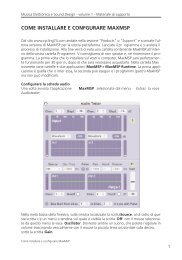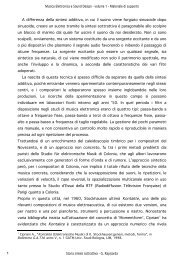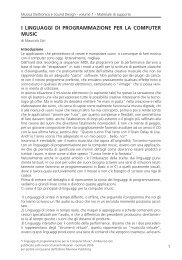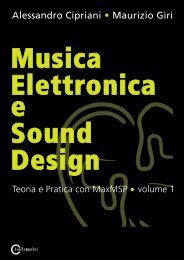programming with max/msp - Virtual Sound
programming with max/msp - Virtual Sound
programming with max/msp - Virtual Sound
Create successful ePaper yourself
Turn your PDF publications into a flip-book with our unique Google optimized e-Paper software.
Interlude B - Additional elements of <strong>programming</strong> <strong>with</strong> Max/MSP<br />
IB.1 INTRODUCTION TO MIDI<br />
MIDI is a protocol for communicating between electronic and/or digital musical<br />
instruments and computers. Using a physical MIDI cable, it is possible to connect<br />
a synthesizer to a computer, enabling the computer to “play” synthesizer, for<br />
example. Using the MIDI protocol, the computer sends notes to the synthesizer<br />
along <strong>with</strong> the intensity <strong>with</strong> which they should be played, their durations, and<br />
other information.<br />
MIDI instruments do not need to exist in physical form: they can also run as “virtual”<br />
instruments, which are computer applications that simulate the behavior of<br />
real instruments and produce sound through audio interfaces. Such digital instruments<br />
can communicate via MIDI, just as real-world instruments do. Programs<br />
like Max/MSP can send MIDI commands directly to a receiving program such as a<br />
virtual instrument. Indeed, Max has many objects that exploit the MIDI protocol,<br />
as we will learn in more detail in Chapter 9, but for the moment, we will stick to<br />
a basic subset that is used to manage MIDI messages.<br />
Open the file IB_01_MIDI_note.<strong>max</strong>pat; Figure IB.1 shows the upper part of<br />
the Patcher Window.<br />
Fig. IB.1 The upper part of the patch contained in IB_01_MIDI_note.<strong>max</strong>pat<br />
We have connected the kslider object (the musical keyboard) to some<br />
number boxes, which then connect to a noteout object. As we have already<br />
learned, clicking on one of the kslider keys will generate the MIDI note value<br />
for the selected key on the left outlet. (We first used this object in Section 1.4.)<br />
Pressing a key also generates a velocity value on the right outlet that represents<br />
an intensity for the note; clicking on the upper part of the key will produce<br />
a higher velocity value, while clicking on the lower part will produce a lower<br />
value. (On physical keyboards, velocity actually reflects the velocity <strong>with</strong> which<br />
the key is pressed, hence the origin of the term.) Values for velocity can vary<br />
between 1 and 127 in MIDI.<br />
Note and velocity values are sent to the left and center inlets of a noteout<br />
object, which then sends the appropriate command to any MIDI instruments<br />
(real or virtual) that are connected to it. 1 In the MIDI protocol, this message is<br />
1 The right inlet of the noteout object is used to set the MIDI channel, which we don’t need at<br />
the moment. The details of this will be forthcoming in Chapter 9.<br />
from “Electronic Music and <strong>Sound</strong> Design” Vol. 1 by Alessandro Cipriani and Maurizio Giri<br />
© ConTempoNet 2010 - All rights reserved<br />
IB<br />
423







